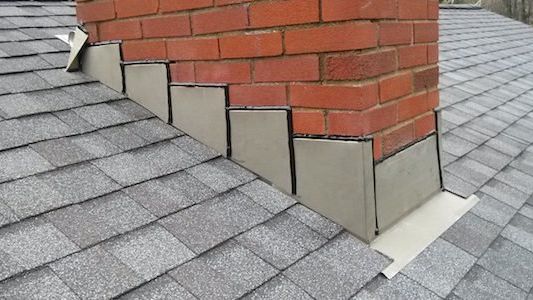This time of year, during the winter, most of us are using our fireplaces.
Some of the fireplaces have masonry chimneys, which are built of stone, brick, blocks, and/or mortar.
These chimneys are heavy and rugged but they attract water issues. More and more people have experienced such issues the last few months thanks to major weather systems like Hurricanes Florence and Michael along with Winter Storm Avery.
Though chimneys seem like they’d hold up great against extreme weather, that is not always the case….
There are a variety of reasons that chimneys take on water. A common issue is the top of the crown being flat, causing the exterior of the chimney to be partially exposed to the elements at all times. We will discuss how this can lead to water leaks below.
Too much water can eventually cause rust, wood rot to the wall sheathing materials, clogging, staining, cracking of the mortar at key joints, and collapsing or resettling the chimney away from the house.

How Can You Spot a Leaky Chimney?
Two key areas you want to work on to prevent chimneys from leaking are the flashing and the top of the chimney.
Flashing
Flashing is a thin piece of metal and caulking that is used to prevent water from penetrating the space between your roof and your chimney.
When done properly it is very effective, but over time or with the wrong process it can easily become a major problem and cause a leaky roof, you can read more about roof leaks here.

Properly flashing a chimney is not an easy process.
It requires many layers of protection including a sub-layer of ice guard, a step flashing layer incorporated into the shingles, and a layer of counterflashing.
This specific approach allows the chimney to flex during times of extreme cold and heat. If you are noticing a leaky roof around the chimney it is time to call a professional who can properly repair the flashing.
Top of the Chimney
Another common issue is the top or crown of the chimney tends to retain water.
Cracks to the crown and the brick surrounding the chimney can cause major damage to the home.
Caulking these areas provides a temporary fix, but unfortunately, under normal thaw and freeze cycles it will just break the seal and continue to cause problems.
Repairing with the right type of mortar or installing a chimney cap that covers the circumference of the top of the chimney creates a more permanent solution.
Once it has been determined that the chimney is leaking, it must be properly sealed.
The Chimneys Plus Waterproofing Process
Chimneys Plus have an extensive process to ensure that your chimney is waterproofed and functioning properly.
We don’t cut corners and make sure that we do the job right the first time so that you don’t have to worry about issues coming up later.
Below is our six-step Waterproofing process:
- Measurement: We first measure it in order to determine the amount of sealant needed.
- Chimney Preparation: Next, we thoroughly clean your chimney so that all mold or moss is removed.
- Siding, Roof, and Window Protection: Sealants may discolor or damage certain areas of the home, so we protect the rest of the siding, roof, and windows with temporary tarps and coverings.
- Chimney Repair and Repointing: After the cleaning of the chimney is complete, larger cracks are repointed and sealed with a specific type of mortar. Using Type S Mortar provides your chimney with a stronger seal and keeps your chimney looking uniform.
- Waterproofing Application: Once all of the previous steps have been completed, it is time to apply sealant. We recommend only using products like Chimney Saver, which is STRICTLY meant to waterproof your chimney. Other products may remove the ability of the bricks to dry or cause other unforeseen ramifications.
- Checking and Jobsite Clean Up: Once the job has been completed, it is time to pick up. A clean area will not only make you feel great about your work, but it will also make your chimney stand out in the neighborhood!
Water issues with a masonry chimney are never fun and can cause a lot of stress.
As with most things, catching issues early can prevent further, costly damage to your home.
It is important to rely on mechanically solving the problem before applying a sealant!
A large cap can go a long way to solving a water problem.
Water that is retained at the top of the chimney can travel all the way through the system. The older the chimney, the more time that has passed for water to create pathways through the system and into your home.
Lastly, always remember:
Low-cost options solve symptoms, but it normally takes something a little more extensive to remedy the actual situation and prevent larger problems.

Is your Chimney leaking? Or are you interested in waterproofing your chimney to prevent future leaks and damage?
If so, click the button below and contact Chimneys Plus.
We will be more than glad to help you solve any problems your chimney may be having and work with you to make your chimney as indestructible as possible. Click here to learn more about some of our waterproofing services.
Related Posts
Nothing found.

